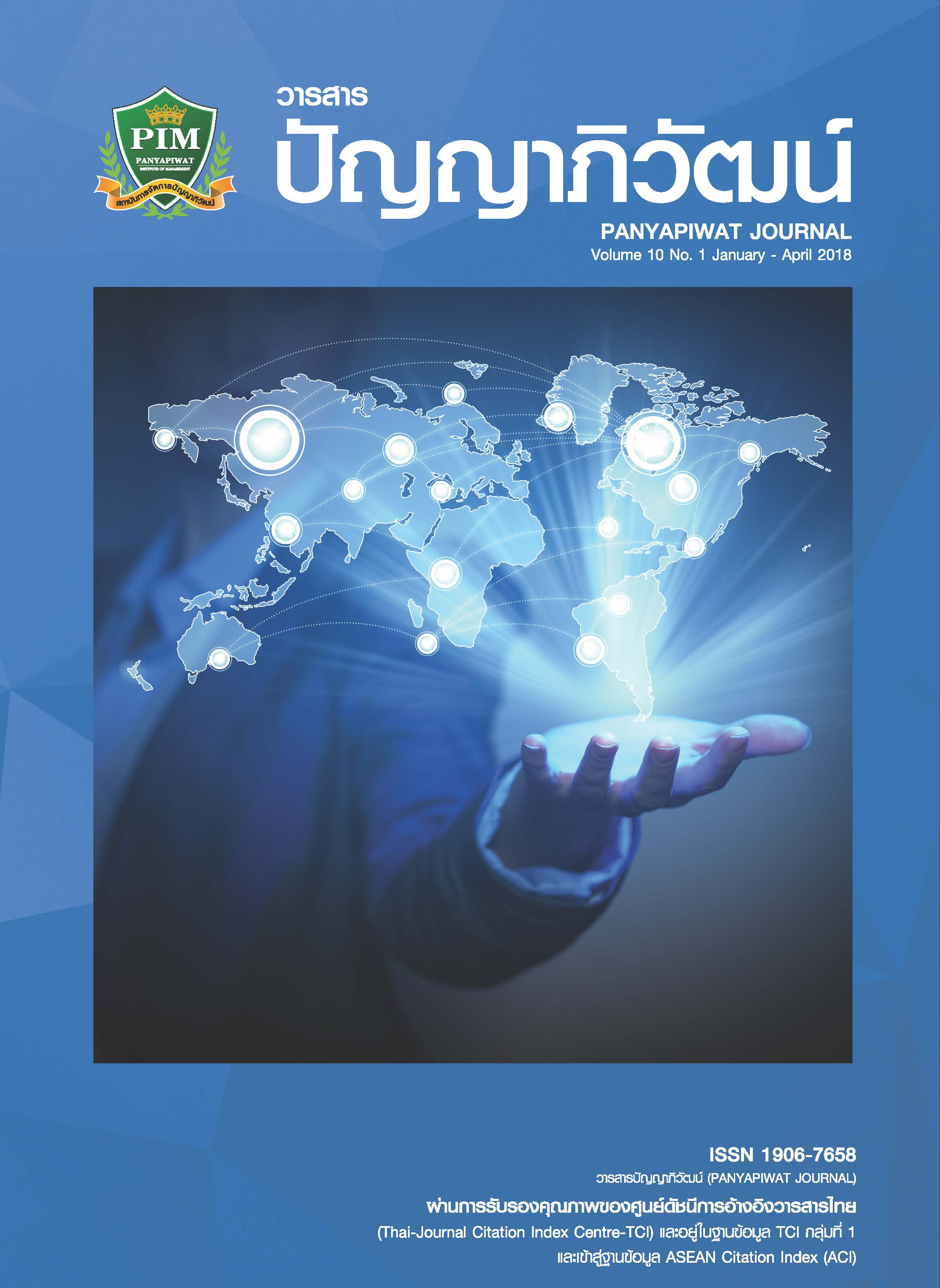ตัวแบบความสัมพันธ์เชิงสาเหตุความเป็นเมืองน่าอยู่ในภาคตะวันออกเฉียงเหนือตอนบน
Main Article Content
บทคัดย่อ
การวิจัยในครั้งนี้มีวัตถุประสงค์เพื่อ 1) พัฒนาตัวแบบความสัมพันธ์เชิงสาเหตุความเป็นเมืองน่าอยู่ในภาคตะวันออกเฉียงเหนือตอนบน และ 2) ศึกษาอิทธิพลทางตรงของปัจจัยด้านเศรษฐกิจ สังคม และสิ่งแวดล้อมที่ส่งผลต่อความเป็นเมืองน่าอยู่ในภาคตะวันออกเฉียงเหนือตอนบน กลุ่มตัวอย่างคือ ประชาชนที่อาศัยอยู่ในเขตเทศบาลในภาคตะวันออกเฉียงเหนือตอนบน จำนวน 380 ราย ทำการสุ่มตัวอย่างด้วยวิธีการสุ่มอย่างง่าย และเก็บรวบรวมข้อมูลด้วยแบบสอบถาม มีลักษณะเป็นแบบมาตราส่วนประมาณค่า 5 ระดับ โดยผ่านการหาความเที่ยงตรง มีค่าดัชนีความสอดคล้อง (IOC) เท่ากับ 0.94 และผ่านการหาความเชื่อมั่น (Reliability) โดยมีค่าสัมประสิทธิ์แอลฟาของครอนบาคเท่ากับ 0.895 วิเคราะห์ข้อมูลโดยใช้โปรแกรมสำเร็จรูปสำหรับการวิจัยทางสังคมศาสตร์
ผลจากการวิจัยพบว่า ตัวแบบมีความสอดคล้องกับข้อมูลเชิงประจักษ์ โดยพิจารณาจากค่าไคสแควร์ (X2) มีค่าเท่ากับ 109.63 ที่องศาอิสระ (df) 90 P-value เท่ากับ 0.078 ค่าดัชนีวัดระดับความกลมกลืน (GFI) เท่ากับ 0.97 ค่าดัชนีวัดระดับความกลมกลืนที่ปรับแก้แล้ว (AGFI) เท่ากับ 0.95 ค่ารากกำลังสองของความคลาดเคลื่อนโดยประมาณ (RMSEA) เท่ากับ 0.024 และค่ารากของค่าเฉลี่ยกำลังสองของเศษเหลือในรูปคะแนนมาตรฐาน (Standardized RMR) เท่ากับ 0.035 ความเป็นเมืองน่าอยู่ได้รับอิทธิพลทางตรงจากปัจจัยด้านเศรษฐกิจ ปัจจัยด้านสังคม และปัจจัยด้านสิ่งแวดล้อม อย่างมีนัยสำคัญทางสถิติที่ระดับ 0.01 โดยปัจจัยด้านสิ่งแวดล้อมมีค่าอิทธิพลมากที่สุด รองลงมาคือ ปัจจัยด้านเศรษฐกิจ และปัจจัยด้านสังคม ตามลำดับ
This research aims to 1) develop model of healthy city in the upper north east region 2) study the direct effect of economic, social, and environmental factors that influence the healthy city in the upper north east region. The samples were obtained from residents of the municipalities in upper north east region 380 cases were used by means of a simple random sampling. The research instrument was a questionnaire of 5 levels, with the IOC of 0.94 and the reliability of the questionnaire was 0.895. The data was analyzed by software for social science research.
The results of this study indicated that: Model of healthy city in the upper north east region correlates with the empirical data by having X2 = 109.63, df = 90, P-value = 0.078, GFI = 0.97, AGFI = 0.95, RMSEA = 0.024 and Standardized RMR = 0.035. The Healthy City are directly influenced by economic factors, Social factors and environmental factors at the statistically significant level of 0.01. The most direct influential aspect is environmental factors, followed by economic factors and social factors.
Article Details
“ข้าพเจ้าและผู้เขียนร่วม (ถ้ามี) ขอรับรองว่า บทความที่เสนอมานี้ยังไม่เคยได้รับการตีพิมพ์และไม่ได้อยู่ระหว่างกระบวนการพิจารณาลงตีพิมพ์ในวารสารหรือแหล่งเผยแพร่อื่นใด ข้าพเจ้าและผู้เขียนร่วมยอมรับหลักเกณฑ์การพิจารณาต้นฉบับ ทั้งยินยอมให้กองบรรณาธิการมีสิทธิ์พิจารณาและตรวจแก้ต้นฉบับได้ตามที่เห็นสมควร พร้อมนี้ขอมอบลิขสิทธิ์บทความที่ได้รับการตีพิมพ์ให้แก่สถาบันการจัดการปัญญาภิวัฒน์หากมีการฟ้องร้องเรื่องการละเมิดลิขสิทธิ์เกี่ยวกับภาพ กราฟ ข้อความส่วนใดส่วนหนึ่งและ/หรือข้อคิดเห็นที่ปรากฏในบทความข้าพเจ้าและผู้เขียนร่วมยินยอมรับผิดชอบแต่เพียงฝ่ายเดียว”
References
Angsuchoti, S., Wijitwanna, S. & Pinyopanuwat, R. (2008). Statistical Analysis for the Behavioral and Social Science Research: technical using LISREL program. Bangkok: Mission Media.[in Thai]
Barton, H. & Grant, M. (2011). Urban Planning for Healthy Cities: A Review of the Progress of the European Healthy Cities Programme. Journal of Urban Health: Bulletin of the New York Academy of Medicine, 90(Suppl.1), 129-141.
Buranasiri, P. (2009). Healthy City. Retrieved August 8, 2014, from https://sawasdee.bu.ac.th/article/g[440702.htm [in Thai]
Choosuk, C. (2010). Final Report, Mechanisms in Mobilizing the Livable City Policy: the Case Studies of Songkhla and Prik Municipalities, Songkhla Province. Bangkok: Thai Health Promotion Foundation. [in Thai]
Chunloy, M. (2008). The Study of Perception on Livable Cities, Case Study Suthep Sub-District, Muang District, Chiang Mai Province. Thesis, Master of Science, Mahidol University. [in Thai]
Chutan, N. (2012). The Strategy for Developing a Healthy Urban Community based on World Heritage City Identity of Kamphaeng Phet Province. Thesis, Ph.D. (Administration and Development Strategy), Kamphaeng Phet Rajabhat University. [in Thai]
Department of Local Administration. (2015). Information of Local Administrative Organization. Retrieved January 10, 2015, from https://dla.go.th/work/abt/ [in Thai]
Khumhome, B. (2014). Factors Influencing the Decision to Participate in A Green Industial Project of Enterpreneurs in Ubonratchatani. Panyapiwat Journal, 5(Special Issue), 92-104. [in Thai]
Noyraiphoom, J. (2008). The Urban Sufficiency Concept: A Sustainable Urban Design in Thai Pattern. Journal of the Faculty of Architecture, Silpakorn University, 23, 177-198. [in Thai]
Piputsoongnern, P. (2015). Identifying Indicators of Factors Determining Healthy City: Applied Second-order Confirmatory Factor Analysis Model Udon Thani Rajabhat University Journal of Humanities and Social Sciences, 4(1), 31-58. [in Thai]
Rydin, Y. (2012). Viewpoint Healthy cities and planning. The Town Planning Review, 83(4), 13-18. Saguansup, J. (2010). Guidelines for Healthy City Development of Bangtaboon Municipality in Banlaem District of Phetchaburi Province. An Independent Study, Master of Public Administration, Khon Kaen University. [in Thai]
Thadaniti, S. (2007). Sustainable Healthy City. Retrieved August 7, 2014, from https://www.chula.ac.th/resources/download/cu_rel/curel_50_2007.pdf [in Thai]
Thailand Environment Institute Foundation. (2012). Sustainable Healthy Municipality Assessment Handbook 2012. Bangkok: Ministry of Natural Resources and Environment. [in Thai]
The Office of Strategy Management Upper North East Provincial Cluster 1. (2016). Development Plan of Upper North East Provincial Cluster 1, 4 Years (2018-2021 A.D.). Udon Thani: UdonThani City Hall. [in Thai]
Tirakanan, S. (2012). Multivariate Analysis in Social Science Research (2nd ed.). Bangkok: Chulalongkorn University. [in Thai]
Webster, P. & Sanderson, D. (2012). Healthy Cities Indicators-A Suitable Instrument to Measure Health? Journal of Urban Health: Bulletin of the New York Academy of Medicine, 90(Suppl.1), 52-61.

